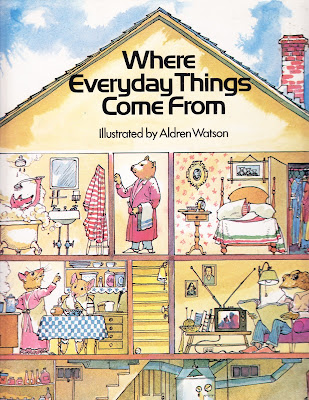Sometime deep in the 1970s, Platt & Munk put out a series of oversize children's books that seemed very inspired by Richard Scarry's Busytown books and/or the general output of Golden Books. (They borrowed several illustrators from the Golden stable for the project as well.) There are lots of animals wearing clothes (moles toil underground, beavers handle all woodwork), and there is a ton of interesting vocabulary and information. I kind of love these books because, as a rule, they are very readable (not too much text, not too little), they are fun, and they are perfect for pulling out as a reference when a particular topic comes in conversation. Up top I have some scans, and down at the bottom of the post I have a clumsy bibliography. Kudos to whichever groovy editrix put this series together back in the 1970s. You done good.
 |
| How Do They Build It? - Tim and Greg Hildebrandt - Platt & Munk, 1974 - ISBN 0-8228-7610-8. |
 |
| Topics: Houses, boats, cars, furniture, roads, skyscrapers, dams, bridges, planes, oil wells. |
 |
| Where Everyday Things Come From - Aldren Watson - Platt & Munk, 1974 - ISBN 0-8228-7611-6, |
 |
| The Big Farm Book - Annie Ingle, illustrated by Aurelius Battaglia - Platt & Munk, 1976 - ISBN 0-8228-7617-5. |
 |
| The Big City Book - Annie Ingle, illustrated by Tim and Greg Hildebrandt - Platt & Munk, 1975 - ISBN 0-8228-7616-7. |
 |
| How Come...? Easy Answers to Hard Questions - Joyce Richards, illustrated by Susan Perl - Platt & Munk, 1975 - ISBN 0-448-13031-9. I think I remember this book from when I was little, or at least I think I remember Susan Perl's spacey, uniquely-haired children from another one of her books. |
 |
| "Where do you do all your thinking?" |
 |
| Baby brainiacs in Susan Perl's imagination, circa 1974. |
How Come...? Easy Answers to Hard Questions
Joyce Richards & Susan Perl
More Easy Answers
Joyce Richards & Susan Perl
Who Invented It and What Makes It Work?
Sarah Leslie & Tom O’Sullivan
Where Everyday Things Come From
Aldren Watson
Letters, Sounds and Words: A Phonic Dictionary
Linda Hayward & Carol Nicklaus
Numbers, Signs and Pictures: A First Number Book
Shari Robinson & Sal Murdocca
The Big Farm Book
Annie Ingle & Aurelius Battaglia
The Big City Book
Annie Ingle & the Hildebrandts
The Curiosity Book: Answers to Questions That Every Child Is Most Curious About
Selma G. Lanes & Robert J. Lee
Louisa Britton & Victor Ramon Mojica
Mabel and the Rainbow
Carol Nicklaus
The Great Big Funny BookSue Lundgren
Mabel and the Rainbow
Carol Nicklaus
The Great Big Funny BookSue Lundgren
The Almost Anything You Might Ask Almanac {I didn't like this one at all and eventually left it at a Little Free Library.}
Pappy Klima
Bernard Garfinkle & Meryl Joseph
Are there other Child Guidance titles out there that I haven't found? I'd love to know about them if there are. Please post in the comments if you find any that aren't listed here, or if you'd like to see more scans from any of the titles above.




















